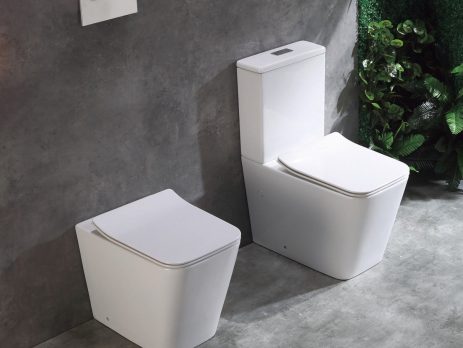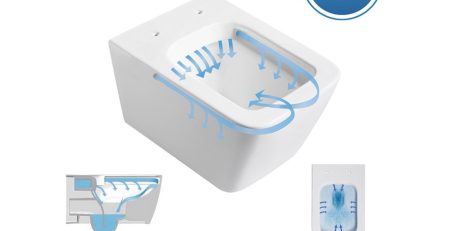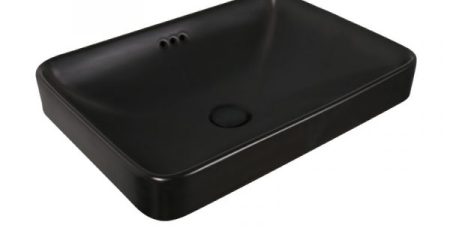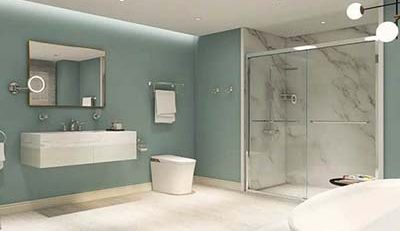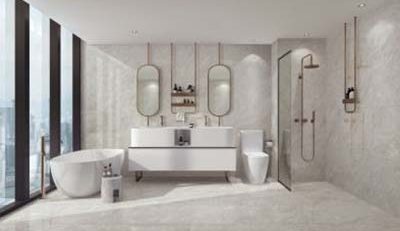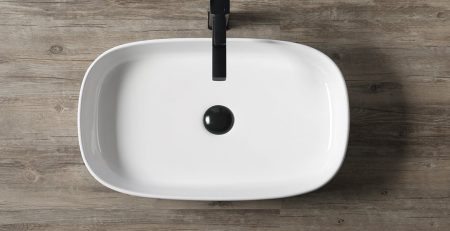Wall hung toilet VS Floor standing toilet
Every home needs a toilet. It is not the fanciest of items, but no bathroom can be complete without it. Many people overlook the toilet when designing or decorating their bathrooms, but toilets now come in various styles and shapes. So, it is worth taking the time to consider which one works best in your bathroom. One of the first questions to ask is whether you want a wall-hung or floor-mounted toilet. This guide will help you decide, looking at the pros and cons of each toilet type.
Appearance
A wall hung toilet is installed with the tank inside the wall with only the bowl protruding out. A floor-mounted or standard toilet has the classic bowl-and-tank design with the tank clearly visible and the bowl connecting down to the floor.
Wall-hung toilets are more modern and minimalistic, taking up less space in the bathroom and giving it a clean, airy aesthetic. They are generally considered more design-oriented, while floor-mounted toilets are more traditional.
If you want a contemporary designer look, a wall-hung toilet is a great choice. However, many one-piece floor-mounted toilets have classy designs as well.



Space aving
A major advantage of a wall-hung toilet is the amount of space you can save. Technically, they are no bigger or smaller than floor-mounted toilets, but because the tank is installed inside the wall, they are more efficiently designed. Since they take up less space, this frees up more room to install other items or appliances like sinks and towel racks.
In particularly tight bathrooms, regular floor-mounted toilets can be difficult to install in a way that meets building code clearance requirements. The National Kitchen & Bath Association recommends at least 24 inches of clear space in front of the toilet, and most codes demand at least 30 inches of free space from the center of the toilet to any other fixture.
With a wall-hung toilet, you can save up to 10 inches compared to a floor-mounted model simply by having the tank in the wall. Not only that, but the bowl can also be positioned at various heights, anywhere from 15 to 19 inches off the ground, freeing up more space underneath the bowl and adding to the open aesthetic in your bathroom.
Height
With a floor-mounted toilet, you must accept the fixed height of your chosen model and cannot make any adjustments due to the shape and design of the toilet. When it comes to wall-hung toilets, however, they can be installed at various heights, ranging from 15 to 19 inches off the ground. Fifteen inches is considered standard, but elderly and disabled individuals may prefer a seat installed slightly higher, which is easier to sit down on.



Installation
Installation is one area in which a classic, floor-mounted toilet holds the advantage. It is easier to fit in a floor-mounted toilet than a wall-hung toilet. This is mostly because with a wall-hung toilet, the tank needs to be fitted into the wall. This is a larger job overall and requires more complicated plumbing.
Installation is more expensive for a wall-hung model because part of the wall needs to be removed and reinforced. In either case, whether you are dealing with a floor-mounted or wall-hung toilet, it is best to hire a professional for the installation.
Costs
One of the drawbacks of wall-hung toilets is that they tend to be more expensive, both in terms of material costs and installation costs. Often, seats and tanks are sold separately when it comes to wall-hung toilets, which can increase the overall price tag.
Since wall-hung toilets tend to have more variation in their shape and design, the price range can go quite high, anywhere from around $500 to $2,000 or higher. In comparison, a floor-mounted toilet can be purchased for around $220 to $350.
For installation, a wall-hung toilet typically requires more labor, leading to average installation costs of around $350, while a standard toilet can be installed for about $180. Expect to pay about twice as much for installation, but prices vary in different areas.
For example, a Toto Maris Duofit wall-hung toilet costs around $1,000 and then another $350 to install, for a total cost of $1,350. Meanwhile, a Toto Entrada floor-mounted toilet costs $200 with around $180 required for installation, for a total overall cost of $380.
Cleaning
Wall-hung toilets are easier to clean for two reasons. First, they do not touch the floor, leaving the space underneath easy to access for cleaning. Since the tank is in the wall and you only have one main piece (the bowl) to clean, there are fewer nooks and crevices for dust and dirt to build up.
A floor-mounted toilet has a greater surface area that needs to be cleaned, and classic two-piece designs have little spaces where dirt and dust can gather, such as the space between the bowl and tank.
Repairs
When it comes to repairs, wall-hung toilets are generally more time-consuming and difficult to fix because the tank is inside the wall, making access more difficult. However, some models feature access panels that allow repair workers to get to the tank without needing to tear the wall down. In most cases, floor-mounted toilets are simpler to fix because all the parts are out in the open for easy access.
Noise
If the loud noise of a flushing toilet is something that bothers you, a wall-hung toilet might be a good choice. Since the tank is inside the wall, the sound of it refilling after each flush is much quieter.

